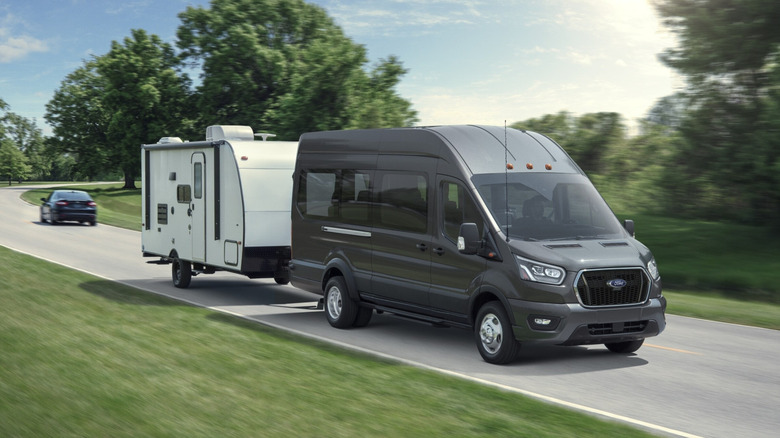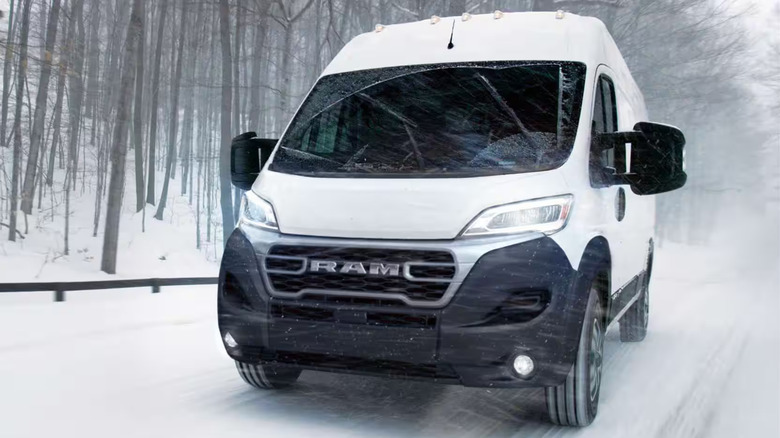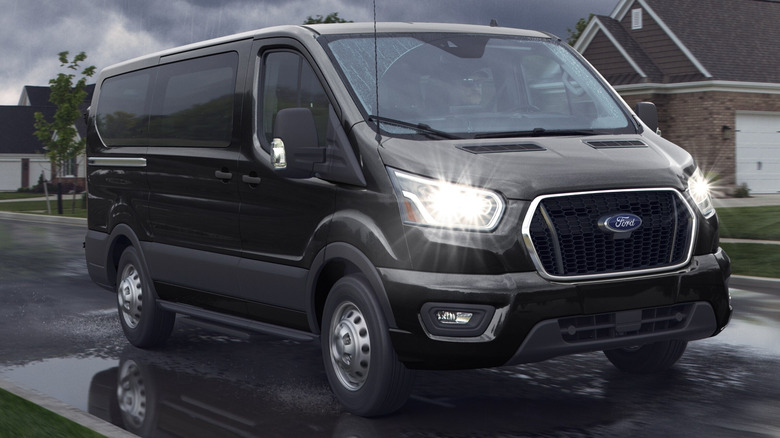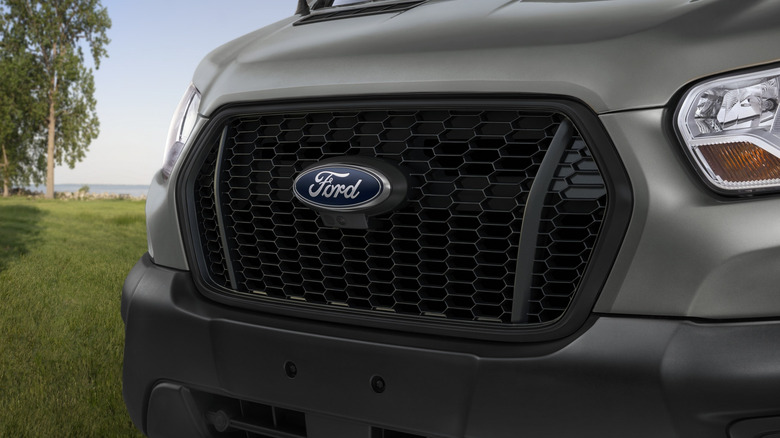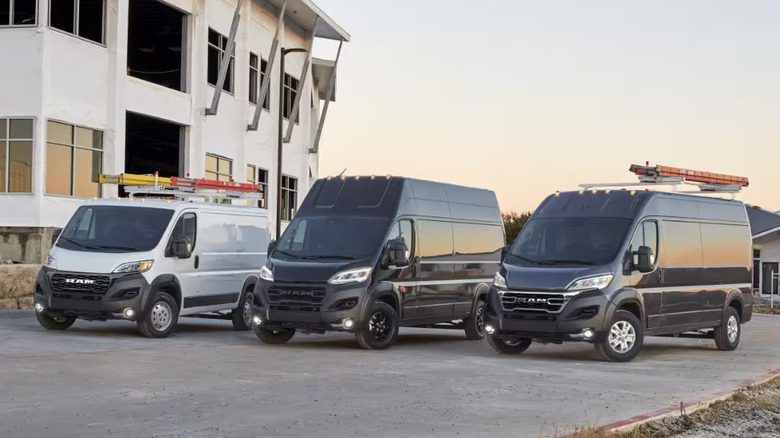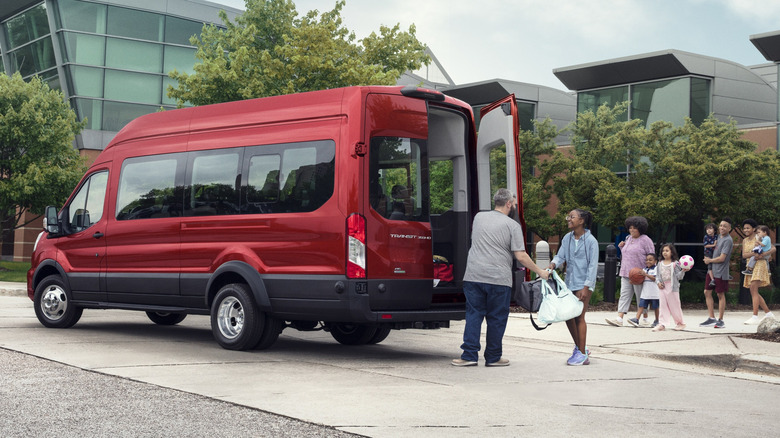Ford Transit Vs. Ram Promaster: Which Is The Better Starter For Van Life?
Van life has skyrocketed in popularity over the last few years. It's been glorified with influencers giving us tours of their vans, walkarounds of their minibusses, and how-tos on building the best rig — all while racking up followers along the way. With the rise in popularity comes an obvious question: "How can I get in on all the fun that van life seems to be providing these happy people?" Well, if you're looking for a van to live in, there are some pretty compelling choices that you can buy brand new these days, including options from both Ford and Ram — the Transit and the ProMaster. They're both a bit less expensive than options like the ritzy Mercedes-Benz Sprinter van, and they both come in a number of configurations worth exploring.
I've spent months at a time on the road, living out of my home-built adventure van, so I know a good van when I see one. I've helped friends conceptualize and build vans of their own, and I've steered friends and family members away from van purchases that they just plain didn't need (sometimes, a rental RV for bi-yearly adventures is a much better choice). Through these various van adventures, I've learned a lot (through trial and error and through research) about what makes a van useful for everyday living. I've also learned which upgrades to skip and which ones are must-haves.
Prioritizing your build
Before we get into the nitty-gritty of whether you should choose the Transit or the ProMaster for your van build, let's talk about priorities. When planning your van build, be realistic about what you'd like to do and what you actually plan on doing with the van. Not everyone needs an off-road capable van or something that can tow 10,000 pounds.
I recommend renting a few vans first to get a sense of what amenities you can't live without. Before your build, create a list with three categories: Must-haves, nice-to-haves, and unnecessary luxuries. Sorting out what you need into categories will help you budget your van build and get a sense of just how much stuff you'll be trying to squeeze into your van's interior.
The list for my van build was pretty simple. I needed something that could hold my motorcycle for long road trips, tow my car to the racetrack, and have a comfortable place for me to sleep. Everything else was an optional upgrade. For full-time van lifers, extra requirements like a shower, a toilet, and a high-roof configuration that's big enough to stand up inside will all be worthy considerations. Don't skip this step before you start your build, or it could cost you a lot of extra money in the long run.
Powertrains and performance
Once you've got your list of priorities all set, you can start to look at the powertrain choices offered by these two vans. While sheer acceleration probably won't be your top concern when purchasing a van, you'll still need enough power to pull your mobile living unit around, so which engine you choose matters. Under the hood of the Ram ProMaster is a 3.6-liter V6 with 276 horsepower and 250 lb-ft of torque. It's paired with a nine-speed automatic transmission, and it comes standard with front-wheel drive. Unfortunately for the Ram ProMaster, all-wheel drive isn't an option — so van lifers will need to be extra cautious when it comes to inclement weather.
The Transit offers two choices for the engine –- either the standard naturally-aspirated 3.5-liter V6 or the turbocharged 3.5-liter V6 called the EcoBoost. The standard engine produces 275 hp and 262 lb-ft of torque, but the EcoBoost does much better, with 310 hp and a hefty 400 lb-ft of torque. A 10-speed automatic transmission is standard with both engines. Rear-wheel drive is standard on the Transit, but all-wheel drive is an available option. The simple availability of an extra powertrain gives the Transit a big leg up in this category, but the addition of available all-wheel drive separates these two vans even further.
Towing, hauling, and most-importantly, payload
When building my van, I knew that I was planning on towing with it. Hooking up a trailer and heading to the racetrack required a specific amount of towing power. So I needed something with at least 5,000 pounds of towing capacity (a Uhaul trailer weighs about 2,200 pounds, and my track car weighs about 2,700 pounds). The Ram ProMaster could've handled the task with an available towing capacity of 6,910 pounds. Max towing for the Transit with an EcoBoost is 6,900 pounds, so it's essentially a tie between these two.
There's a difference between towing and payload, however, and payload is probably more important for more people interested in van life. Adding items like insulation, furniture, plumbing, electrical infrastructure, and all your clothing items to the interior of a van — it all has to be calculated as a part of the payload. Passengers need to be included, too, as does any weight you add on top of your van in the form of a roof rack or rooftop storage.
Finally, keep in mind that extra features added to your van change the payload, as does the specific configuration you choose. As far as the maxes go, however, the Ford Transit checks in at 5,110 pounds of payload capacity. The ProMaster checks in with a maximum payload of 4,680 pounds. That's still a significant amount of weight, but over 400 pounds less than what the Transit can handle. Advantage: Ford.
Pricing and warranty
Knowing what features you want in your van will obviously help you narrow down the price range, but a good starting place is looking at each van's MSRP. The 2025 Ram ProMaster starts at $44,960 (plus destination) for the basic 1500 series 118-inch wheelbase model with a low roof. Topped-out 3500 series versions of the ProMaster with the 159-inch wheelbase, side windows, and a high roof start at $61,120 (plus destination). The Ram ProMaster comes with a standard 3-year/36,000-mile warranty, with 5 years/60,000 miles of powertrain coverage.
With the Transit, things are a bit pricier. The standard Transit cargo van with a low roof and a 130-inch wheelbase starts at $49,495 (including a $2,095 destination fee). The 3.5-liter EcoBoost engine is a $2,700 option and prices go up from there. With the high roof, the extended 148-inch wheelbase, windows all around (windows all optional on the cargo van), the EcoBoost engine, and dual rear wheels for extra towing capacity, the Transit checks in at $60,320, just slightly below the ProMaster.
Just like Ram, Ford offers a 3-year 36,000-mile warranty and 5-year 60,000-mile powertrain coverage. For the most part, that's the story with these two vans. Most configurations are within a few thousand dollars of each other if not a few hundred dollars, so there's not a distinct advantage between the two brands in that department.
Roof height for standing up inside
The ProMaster can be had in low or high roof configurations, or you can upgrade to the Super High roof, but it's only available on the 159-inch wheelbase 3500-series model. The result, however, is a massive amount of headroom. The standard roof ProMaster measures 66 inches tall inside, and the high roof measures 77 inches – both are adequate numbers for sure. The Super High roof though, it'll fit even your tallest friends — with 86 inches of cargo height on the inside.
The maximum cargo height on the interior of the high-roof Transit is 81.5 inches — tall enough for most sub-NBA-height humans to stand up straight with no problem. The medium-height roof allows for 72 inches of headroom, which should be enough for most adults, but it might feel cramped after a few months on the road. The low roof tops out at 56.9 inches of cargo height. These numbers are a bit lower than what the ProMaster has to offer, but a maximum 81.5-inch interior height is still very admirable.
It's also worth noting that the taller your van is, the harder time you'll have going under small bridges, parking in crowded cities (you're likely to bump into low-hanging trees), and you'll certainly need to avoid most drive-thru fast-food restaurants. Not to mention the effect an extra few inches of van height will likely have on your fuel economy. Taller is good, but tallest isn't always best.
Accessories and packages
There are a dizzying array of options available for most vans — the Transit and ProMaster are no exception. You'll want to do a bit of your own math as to which items will work better for your build and how much they cost, but let's look at some of the packages and dealer-installed accessories for starters. Aside from the three different roof options and the different interior configurations, the Ford Transit offers three different axles, including one with a limited-slip differential. An RV-Prep package adds features like body-colored bumpers, fog lights, an 8-speaker stereo, cloth upholstery, adaptive cruise control, and a 12-inch center screen.
A similar package on the ProMaster called the Premium Convenience group has features like an upgraded 10.1-inch center screen and smartphone compatibility, with a separate package for adaptive cruise control and blind-spot monitoring to go along with a 360-degree camera. Both vans offer up-fitter packages with pre-installed switches for adding accessories, and both vans offer swivel seats that can be turned around when parked for a nice seating option at camp. Essentially, both the ProMaster and the Transit offer extensive factory accessories — neither has a distinct advantage in this department. And what you can't find from the manufacturer, you're more than likely to be able to source on the aftermarket. In the end, these two vans stack up very well against each other, but the Ford has the advantage in terms of powertrain and overall capability.
